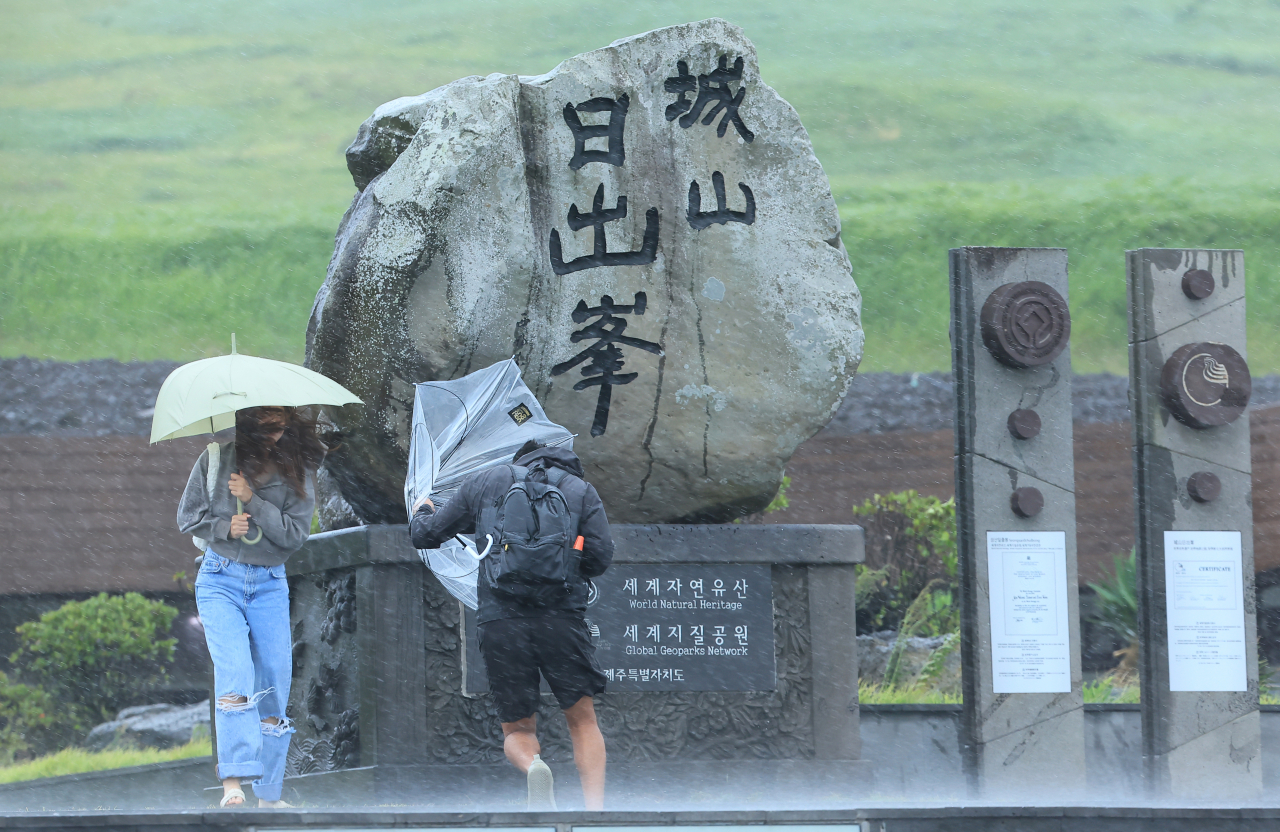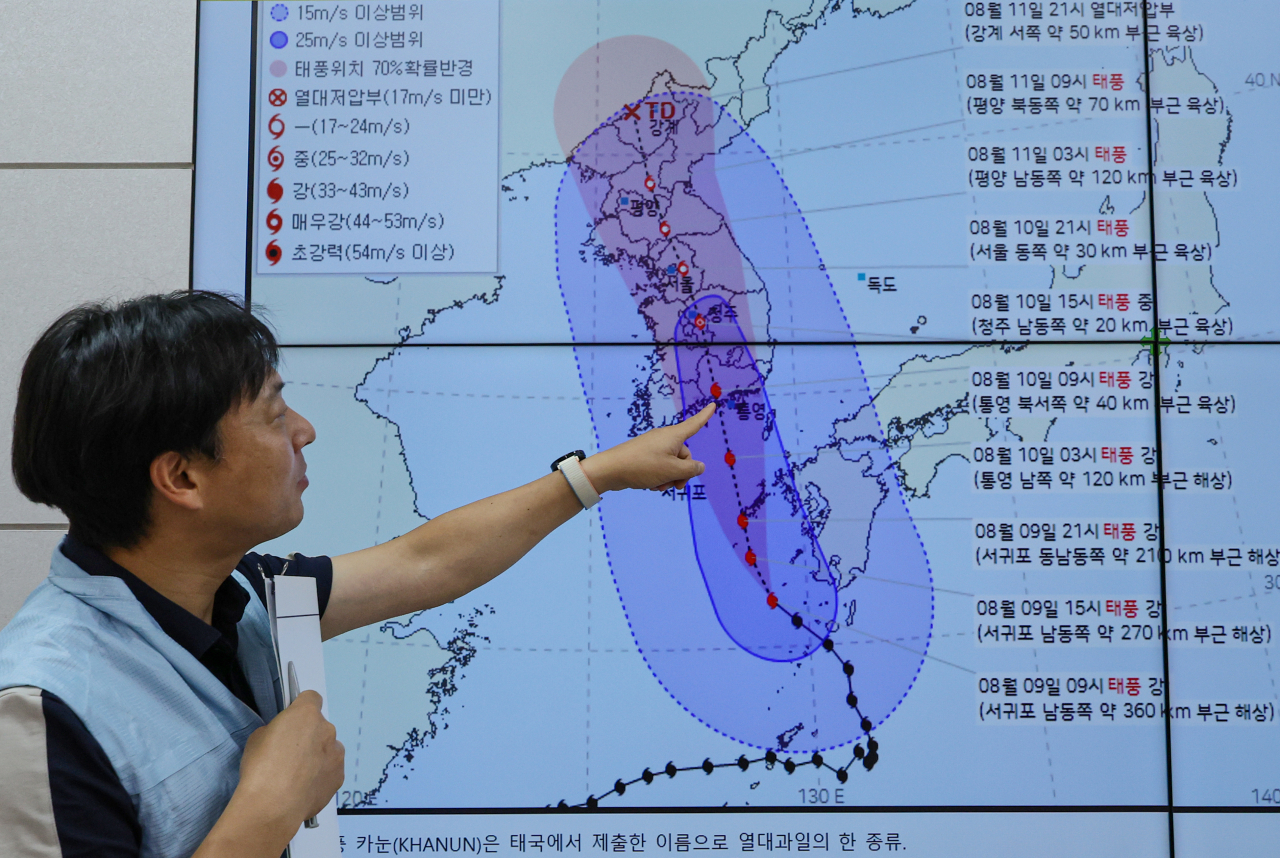Typhoon Khanun to hit S. Korea; flights canceled, evacuations ordered
Govt. urges shift in commute times amid approaching 'strong' typhoon
By Lee Jung-younPublished : Aug. 9, 2023 - 14:49

Fast-approaching Typhoon Khanun has thrown flights and ships into disarray on Wednesday as the national weather agency forecast a powerful storm that could become the first to traverse the entire Korean Peninsula from south to north since records began.
According to the Korea Meteorological Administration on Wednesday, Typhoon Khanun had passed the sea southwest of Kyushu, Japan, and was 360 kilometers southeast of Seogwipo on Jeju Island at 9 a.m.
Khanun was expected to move northward after passing 120 kilometers south of Tongyeong, South Gyeongsang Province, Thursday at 3 a.m., and then make landfall some 40 kilometers northwest of Tongyeong at 9 a.m.
Khanun’s central pressure was expected to be 970 hectopascals as of 9 a.m. Thursday, with maximum wind speeds of up to 126 kilometers per hour, according to the KMA. The agency forecast that the central air pressure would decrease, but that Khanun would pick up speed, meaning the typhoon will likely grow stronger as it approaches.
Khanun is currently categorized as a "strong" typhoon, the third-highest in the five-level system used by the weather agency to classify typhoon strength, meaning that its heavy rain and wind gusts are strong enough to derail a train.
The KMA said Khanun's breadth is large enough to affect the whole country if it follows the projected trajectory.
The area of the typhoon that has a wind speed of 15 meters per second or more spans a 340-kilometer radius out from the center of the typhoon, exceeding the average east-west width of the Korean Peninsula, which is about 300 kilometers.
If Khanun moves as forecast, it will be the first typhoon to run across the Korean Peninsula from south to north since 1951 -- the year the KMA started recording climate data.
The typhoon is expected to come with heavy downpours, dumping more than 600 millimeters of rain in the eastern part of Gangwon Province, more than 300 millimeters in both North and South Gyeongsang Provinces and 100 to 200 millimeters in the Seoul metropolitan area, North and South Jeolla Provinces and North and South Chungcheong Provinces.
Many flights and ferry services to and from Jeju have been canceled or suspended.
As of 11 a.m., 144 flights have been canceled on Jeju Island, including 73 domestic arrivals, 58 departures, six international arrivals and seven international departures, according to the Korea Airports Corp.

Sea routes to and from the island have been completely suspended. The government took measures to anchor all ships on Jeju Island on Tuesday, and closed the ports within the province from 8 p.m.
The Jeju provincial government issued an evacuation order for those outdoors along all coastal areas around the island as of 9 a.m. on Wednesday.
Access to rocks on the seashore, breakwaters, port facilities and coastal cliffs is banned until the evacuation order is lifted, and fines of up to 2 million won ($1,500) will be imposed on anyone who violates the order.
The Interior Ministry and the Central Disaster and Safety Countermeasures Headquarters both raised the crisis alert level ahead of Khanun's expected landfall as of Tuesday 5 p.m., from "warning" to the highest level of "serious," and from 2 to the highest level of 3, respectively.
The crisis alert level 3 of Central Disaster and Safety Countermeasures Headquarters was last raised when Typhoon Hinnamnor hit last September, causing 11 deaths and 1.73 trillion won of property damage.
The government advised that public workers delay their commute times to avoid direct confrontation with the typhoon. Local governments have also been asked to encourage private companies and organizations to modify their commute times in light of the situation.




















